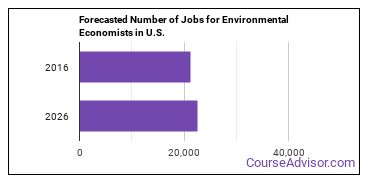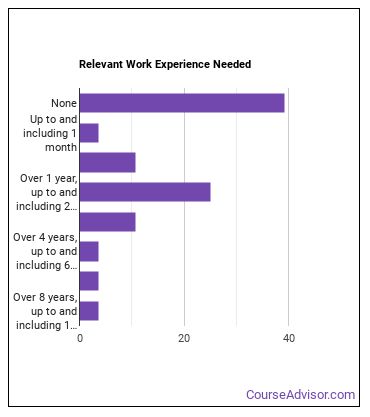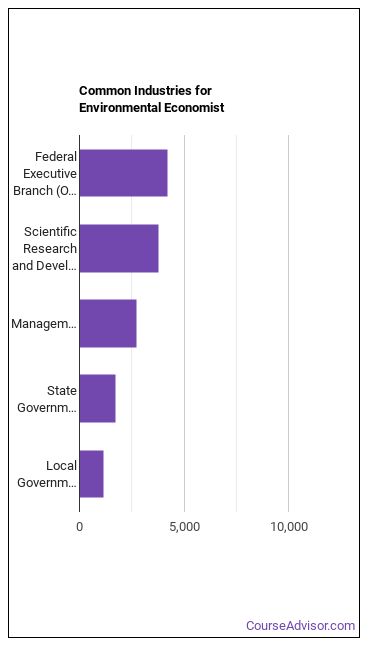What is an Environmental Economist?
Career Description Conduct economic analysis related to environmental protection and use of the natural environment, such as water, air, land, and renewable energy resources. Evaluate and quantify benefits, costs, incentives, and impacts of alternative options using economic principles and statistical techniques.
List of Environmental Economist Job Duties
- Develop environmental research project plans, including information on budgets, goals, deliverables, timelines, and resource requirements.
- Prepare and deliver presentations to communicate economic and environmental study results, to present policy recommendations, or to raise awareness of environmental consequences.
- Identify and recommend environmentally friendly business practices.
- Monitor or analyze market and environmental trends.
- Collect and analyze data to compare the environmental implications of economic policy or practice alternatives.
- Examine the exhaustibility of natural resources or the long-term costs of environmental rehabilitation.
Featured schools near , edit
What Every Environmental Economist Should Know
These are the skills Environmental Economists say are the most useful in their careers:
Reading Comprehension: Understanding written sentences and paragraphs in work related documents.
Writing: Communicating effectively in writing as appropriate for the needs of the audience.
Critical Thinking: Using logic and reasoning to identify the strengths and weaknesses of alternative solutions, conclusions or approaches to problems.
Active Listening: Giving full attention to what other people are saying, taking time to understand the points being made, asking questions as appropriate, and not interrupting at inappropriate times.
Judgment and Decision Making: Considering the relative costs and benefits of potential actions to choose the most appropriate one.
Active Learning: Understanding the implications of new information for both current and future problem-solving and decision-making.
Related Job Titles
- Energy Economist
- Ecological Economist
- Natural Resource Economist
- Economist
- Resource Economist
Are There Job Opportunities for Environmental Economists?
There were about 21,300 jobs for Environmental Economist in 2016 (in the United States). New jobs are being produced at a rate of 6.1% which is above the national average. The Bureau of Labor Statistics predicts 1,300 new jobs for Environmental Economist by 2026. Due to new job openings and attrition, there will be an average of 1,600 job openings in this field each year.

The states with the most job growth for Environmental Economist are Alabama, Louisiana, and Washington. Watch out if you plan on working in Wyoming, West Virginia, or Vermont. These states have the worst job growth for this type of profession.
How Much Does an Environmental Economist Make?
The typical yearly salary for Environmental Economists is somewhere between $58,130 and $182,560.

Environmental Economists who work in District of Columbia, Virginia, or Maryland, make the highest salaries.
Below is a list of the median annual salaries for Environmental Economists in different U.S. states.
| State | Annual Mean Salary |
|---|---|
| Alabama | $103,740 |
| Alaska | $85,970 |
| Arizona | $93,350 |
| Arkansas | $75,380 |
| California | $124,430 |
| Colorado | $104,350 |
| Connecticut | $95,450 |
| Delaware | $86,850 |
| District of Columbia | $134,260 |
| Florida | $105,230 |
| Georgia | $111,570 |
| Hawaii | $98,100 |
| Idaho | $61,130 |
| Illinois | $108,690 |
| Indiana | $84,740 |
| Iowa | $87,530 |
| Kansas | $72,600 |
| Louisiana | $103,070 |
| Maryland | $116,870 |
| Massachusetts | $117,680 |
| Michigan | $90,040 |
| Minnesota | $81,720 |
| Mississippi | $75,450 |
| Missouri | $112,240 |
| Montana | $89,980 |
| Nebraska | $81,010 |
| Nevada | $79,170 |
| New Hampshire | $74,570 |
| New Jersey | $100,500 |
| New Mexico | $87,680 |
| New York | $127,520 |
| North Carolina | $81,470 |
| Ohio | $125,490 |
| Oklahoma | $76,500 |
| Oregon | $87,420 |
| Pennsylvania | $87,630 |
| South Carolina | $68,550 |
| Tennessee | $83,350 |
| Texas | $106,480 |
| Utah | $88,280 |
| Vermont | $96,620 |
| Virginia | $126,080 |
| Washington | $95,010 |
| West Virginia | $68,430 |
| Wisconsin | $80,070 |
What Tools & Technology do Environmental Economists Use?
Although they’re not necessarily needed for all jobs, the following technologies are used by many Environmental Economists:
- Microsoft Excel
- Microsoft Word
- Microsoft Office
- Microsoft PowerPoint
- Microsoft Outlook
- Web browser software
- Microsoft Access
- MySQL
- The MathWorks MATLAB
- SAS
- Microsoft Visual Basic
- IBM SPSS Statistics
- Minitab
- C
- StataCorp Stata
- Wolfram Research Mathematica
- Formula translation/translator FORTRAN
- Insightful S-PLUS
- ESRI ArcGIS software
- Aptech Systems GAUSS
Becoming an Environmental Economist
Individuals working as an Environmental Economist have obtained the following education levels:

How many years of work experience do I need?

Who Employs Environmental Economists?

Environmental Economists work in the following industries:

References:
Image Credit: Bernard Ladenthin via Public domain
More about our data sources and methodologies.
Featured Schools
 Request Info
Request Info
|
Southern New Hampshire University You have goals. Southern New Hampshire University can help you get there. Whether you need a bachelor's degree to get into a career or want a master's degree to move up in your current career, SNHU has an online program for you. Find your degree from over 200 online programs. Learn More > |
